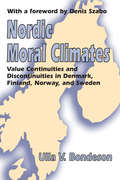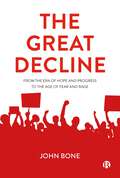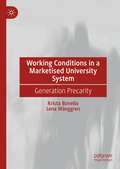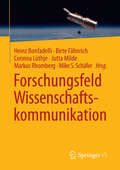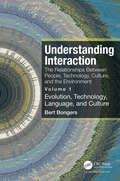- Table View
- List View
Electronic HRM in the Smart Era (The Changing Context of Managing People)
by Tanya Bondarouk Huub Ruël Emma ParryThe HRM field is entering smart businesses where the human, digital and high-tech dimensions seem to increasingly converge, and HRM needs to anticipate its own smart future. Technological developments and interconnectedness with and through the Internet (often called the “Internet of Things”) set new challenges for the HRM function. Smartness enacted by HRM professionals – notions of “smart industries”, “smart things” and “smart services” – all put new pressures on strategic HRM. Since the 1990s, organisations have increasingly been introducing electronic Human Resource Management (e-HRM), with the expectation of improving the quality of HRM and increasing its contribution to firm performance. These beliefs originate from ideas about the endless possibilities of information technologies (IT) in facilitating HR practices, and about the infinite capacity of HRM to adopt IT. This book focuses on the progression from e-HRM to digital (d-HRM) – towards smart HRM. It also raises several important questions that businesses and scholars are confronted with: What kind of smart solution can and will HRM offer to meet the expectations of the latest business developments? Can HRM become smart and combine digitisation, automation and a network approach? How do businesses futureproof their HRM in the smart era? What competences do employees need to ensure businesses flourish in smart industries? With rapid technological developments and ever-greater automation and information available, the HRM function needs to focus on non-routine and complex, evidence-based and science-inspired, and creative and value-added professionally demanding tasks.
Electronic HRM in the Smart Era (The Changing Context of Managing People)
by Tanya Bondarouk Huub Ruël Emma ParryThe HRM field is entering smart businesses where the human, digital and high-tech dimensions seem to increasingly converge, and HRM needs to anticipate its own smart future. Technological developments and interconnectedness with and through the Internet (often called the “Internet of Things”) set new challenges for the HRM function. Smartness enacted by HRM professionals – notions of “smart industries”, “smart things” and “smart services” – all put new pressures on strategic HRM. Since the 1990s, organisations have increasingly been introducing electronic Human Resource Management (e-HRM), with the expectation of improving the quality of HRM and increasing its contribution to firm performance. These beliefs originate from ideas about the endless possibilities of information technologies (IT) in facilitating HR practices, and about the infinite capacity of HRM to adopt IT. This book focuses on the progression from e-HRM to digital (d-HRM) – towards smart HRM. It also raises several important questions that businesses and scholars are confronted with: What kind of smart solution can and will HRM offer to meet the expectations of the latest business developments? Can HRM become smart and combine digitisation, automation and a network approach? How do businesses futureproof their HRM in the smart era? What competences do employees need to ensure businesses flourish in smart industries? With rapid technological developments and ever-greater automation and information available, the HRM function needs to focus on non-routine and complex, evidence-based and science-inspired, and creative and value-added professionally demanding tasks.
Nordic Moral Climates: Value Continuities and Discontinuities in Denmark, Finland, Norway, and Sweden
by Ulla BondesonMorality was a dominant theme in the 1990s, but concerns about morality seem omnipresent in the first years of the third millennium. The year 2002 witnessed the greatest corporate scandals ever seen in the United States, with immense impact financially and in human terms. Sex scandals were pervasive among Catholic priests in the United States, disrupting the lives of thousands of abused children. In Scandinavia, moral debates and scandals are of a smaller magnitude, and more often related to questions about the handling of money by politicians.This volume takes an overarching look at the impact of such moral questions in the Nordic countries. Its approach is multi-disciplinarian, embracing philosophy, history, sociology, and political science. Based mainly upon a survey of representative samples in Denmark, Finland, Norway, and Sweden, this unique study combines interview questions on crime and justice with moral questions concerning equality, confidence, tolerance, and also personal, social, religious, political, and national values. Bondeson first discusses the Nordic countries from a historical perspective and in statistical terms. She then presents interview data on the general sense of justice in Nordic countries, in particular exploring how much social and legal equality the Scandinavians have achieved in their welfare states. She touches upon criminal behavior and victimization, and discusses crime prevention and punishment. Bondeson also reviews the problems and methods of the study. Finally, she adds depth to the statistical analysis by using a number of indexes of morality. A trend analysis illustrates the stability of these attitudes over time.Nordic Moral Climates is an original empirical study of moral values in Scandinavia. It is one of the few comprehensive studies on this subject conducted in any nation or group of nations. The book will be of great interest to criminologists, sociologists, and social theorists.
Alternatives to Imprisonment: Intentions and Reality
by Ulla V. BondesonThe detrimental effects of imprisonment have been documented and accepted in most western countries. As a result, alternatives to incarceration have been sought in the effort to reform the penal system. Although during the last thirty years several Nordic official committees have recommended a reduction in the use of jail sentences and an increase in other forms of punishment (i.e. fines and probation) in the hope of decreasing crime and rehabilitating criminals, incarceration rates have been going up in Sweden, Denmark, and Norway. Still, the interest in alternatives to imprisonment continues to grow, but few studies have actually been published that examine their effectiveness.
Alternatives to Imprisonment: Intentions and Reality
by Ulla V. BondesonThe detrimental effects of imprisonment have been documented and accepted in most western countries. As a result, alternatives to incarceration have been sought in the effort to reform the penal system. Although during the last thirty years several Nordic official committees have recommended a reduction in the use of jail sentences and an increase in other forms of punishment (i.e. fines and probation) in the hope of decreasing crime and rehabilitating criminals, incarceration rates have been going up in Sweden, Denmark, and Norway. Still, the interest in alternatives to imprisonment continues to grow, but few studies have actually been published that examine their effectiveness.
Nordic Moral Climates: Value Continuities and Discontinuities in Denmark, Finland, Norway, and Sweden
by Ulla V. BondesonMorality was a dominant theme in the 1990s, but concerns about morality seem omnipresent in the first years of the third millennium. The year 2002 witnessed the greatest corporate scandals ever seen in the United States, with immense impact financially and in human terms. Sex scandals were pervasive among Catholic priests in the United States, disrupting the lives of thousands of abused children. In Scandinavia, moral debates and scandals are of a smaller magnitude, and more often related to questions about the handling of money by politicians.This volume takes an overarching look at the impact of such moral questions in the Nordic countries. Its approach is multi-disciplinarian, embracing philosophy, history, sociology, and political science. Based mainly upon a survey of representative samples in Denmark, Finland, Norway, and Sweden, this unique study combines interview questions on crime and justice with moral questions concerning equality, confidence, tolerance, and also personal, social, religious, political, and national values. Bondeson first discusses the Nordic countries from a historical perspective and in statistical terms. She then presents interview data on the general sense of justice in Nordic countries, in particular exploring how much social and legal equality the Scandinavians have achieved in their welfare states. She touches upon criminal behavior and victimization, and discusses crime prevention and punishment. Bondeson also reviews the problems and methods of the study. Finally, she adds depth to the statistical analysis by using a number of indexes of morality. A trend analysis illustrates the stability of these attitudes over time.Nordic Moral Climates is an original empirical study of moral values in Scandinavia. It is one of the few comprehensive studies on this subject conducted in any nation or group of nations. The book will be of great interest to criminologists, sociologists, and social theorists.
Social Problems: A Human Rights Perspective
by Eric BondsThis short book lays out a new definition for what constitutes a social problem: the violation of a group’s human rights, which are understood as commonly upheld standards about what people deserve and should be protected from in life. Evaluating U.S. society from an international human rights perspective, Bonds also stresses that human rights are necessarily political and can therefore never be part of a purely objective exercise to assess wellbeing in a particular society. His approach recognizes that there is no one single interpretation of what rights mean, and that different groups with differing interests are going to promote divergent views, some better than others. This book is ideal for undergraduate sociology courses on social problems, as well as courses on social justice and human rights.
Social Problems: A Human Rights Perspective
by Eric BondsThis short book lays out a new definition for what constitutes a social problem: the violation of a group’s human rights, which are understood as commonly upheld standards about what people deserve and should be protected from in life. Evaluating U.S. society from an international human rights perspective, Bonds also stresses that human rights are necessarily political and can therefore never be part of a purely objective exercise to assess wellbeing in a particular society. His approach recognizes that there is no one single interpretation of what rights mean, and that different groups with differing interests are going to promote divergent views, some better than others. This book is ideal for undergraduate sociology courses on social problems, as well as courses on social justice and human rights.
Social Problems: A Human Rights Perspective (Framing 21st Century Social Issues)
by Eric BondsSocial Problems: A Human Rights Perspective, Second Edition evaluates U.S. society through an international human rights framework. The book provides a critical discussion about what rights mean, along with a sociological exploration of power and inequality to explain why human rights are so often violated or left ignored and unfulfilled in the United States. In each chapter, the book offers numerous policy alternatives that could provide a pathway toward the increased fulfillment of rights, while also stressing the important role that nonviolent social movements have had, and must have in the future, in achieving greater justice, dignity, wellbeing, and environmental protection in our society. This edition includes several new chapters on topics of major interest to students, including: the human right to health climate change and human rights immigration and human rights violations in U.S. society a new discussion of the #BlackLivesMatter movement. Social Problems gives social science students a new way to understand pressing social issues that exist in their own communities.
Social Problems: A Human Rights Perspective (Framing 21st Century Social Issues)
by Eric BondsSocial Problems: A Human Rights Perspective, Second Edition evaluates U.S. society through an international human rights framework. The book provides a critical discussion about what rights mean, along with a sociological exploration of power and inequality to explain why human rights are so often violated or left ignored and unfulfilled in the United States. In each chapter, the book offers numerous policy alternatives that could provide a pathway toward the increased fulfillment of rights, while also stressing the important role that nonviolent social movements have had, and must have in the future, in achieving greater justice, dignity, wellbeing, and environmental protection in our society. This edition includes several new chapters on topics of major interest to students, including: the human right to health climate change and human rights immigration and human rights violations in U.S. society a new discussion of the #BlackLivesMatter movement. Social Problems gives social science students a new way to understand pressing social issues that exist in their own communities.
Race, Politics, and Community Development Funding: The Discolor of Money
by Michael BondsLearn how racial and political bias often contribute to the misuse of funding and affect low income and minority communities! Share an insider&’s view of how race and politics impact the distribution of city services and how the promises of elected African Americans and liberal whites to poor communities are often broken. Authored by a noted expert in urban studies, Race, Politics, and Community Development Funding: The Discolor of Money follows federal money designated to alleviate urban poverty and blight at the local level. Using a variety of research methods, the author shows how key actors (mayor, council members, public bureaucrats) often contribute to the misuse of funds. Race, Politics, and Community Development Funding follows the trail of over $247 million allocated to the city of Milwaukee, Wisconsin, from 1975 to 1997. You&’ll learn where money designated to address problems of urban blight and poverty really went. Through interviews, participant observation, trace analysis, and a careful review of public records, this illuminating book follows that money and reveals the errors of those who argued that an increase in the number of black elected officials and community activists would result in more resources for low-income areas. Helpful charts, tables, and graphs illustrate the flow of federal dollars. With Race, Politics, and Community Development Funding you&’ll gain a better understanding of: how public bureaucracies are an extension of the executive branch, as opposed to being independent public agencies how some agencies have used a variety of inaccurate and biased methods and evaluations to fund-or not fund-community based organizations the shortcomings of African-American elected officials and biracial coalitions in obtaining resources for minority communities how education, job training, and youth/family services are as important as who gets elected to office and more! Race, Politics, and Community Development Funding: The Discolor of Money is a valuable resource for community organizers, low-income and minority advocates, undergraduate and graduate students interested in public policies, elected officials and bureaucrats who make funding and implementation decisions, and everyone interested in racial politics and urban community development.
Race, Politics, and Community Development Funding: The Discolor of Money
by Michael BondsLearn how racial and political bias often contribute to the misuse of funding and affect low income and minority communities! Share an insider&’s view of how race and politics impact the distribution of city services and how the promises of elected African Americans and liberal whites to poor communities are often broken. Authored by a noted expert in urban studies, Race, Politics, and Community Development Funding: The Discolor of Money follows federal money designated to alleviate urban poverty and blight at the local level. Using a variety of research methods, the author shows how key actors (mayor, council members, public bureaucrats) often contribute to the misuse of funds. Race, Politics, and Community Development Funding follows the trail of over $247 million allocated to the city of Milwaukee, Wisconsin, from 1975 to 1997. You&’ll learn where money designated to address problems of urban blight and poverty really went. Through interviews, participant observation, trace analysis, and a careful review of public records, this illuminating book follows that money and reveals the errors of those who argued that an increase in the number of black elected officials and community activists would result in more resources for low-income areas. Helpful charts, tables, and graphs illustrate the flow of federal dollars. With Race, Politics, and Community Development Funding you&’ll gain a better understanding of: how public bureaucracies are an extension of the executive branch, as opposed to being independent public agencies how some agencies have used a variety of inaccurate and biased methods and evaluations to fund-or not fund-community based organizations the shortcomings of African-American elected officials and biracial coalitions in obtaining resources for minority communities how education, job training, and youth/family services are as important as who gets elected to office and more! Race, Politics, and Community Development Funding: The Discolor of Money is a valuable resource for community organizers, low-income and minority advocates, undergraduate and graduate students interested in public policies, elected officials and bureaucrats who make funding and implementation decisions, and everyone interested in racial politics and urban community development.
The Great Decline: From the Era of Hope and Progress to the Age of Fear and Rage
by John BoneIt seems clear that many formerly stable societies in wealthy developed countries appear to be falling into an apparent state of ‘permacrisis' accompanied by an increasingly angry and irrational social and political culture that is undermining the peace and stability of our societies and democratic institutions, from the local to the global. Applying an original biosocial approach (the social map), and drawing on ideas and evidence from sociology, history and political economy, to psychology, neuroscience and epigenetics, John Bone argues that conditions in our turbocapitalist and increasingly estranged, media dominated societies have created a toxic environment, deeply damaging to our mental and physical health. As well as shedding new light on our current troubles, Bone also outlines why this leaves us ill prepared to deal with two of the greatest challenges confronting humanity: the rise of AI and automation and how we deal with climate change.
The Great Decline: From the Era of Hope and Progress to the Age of Fear and Rage
by John BoneIt seems clear that many formerly stable societies in wealthy developed countries appear to be falling into an apparent state of ‘permacrisis' accompanied by an increasingly angry and irrational social and political culture that is undermining the peace and stability of our societies and democratic institutions, from the local to the global. Applying an original biosocial approach (the social map), and drawing on ideas and evidence from sociology, history and political economy, to psychology, neuroscience and epigenetics, John Bone argues that conditions in our turbocapitalist and increasingly estranged, media dominated societies have created a toxic environment, deeply damaging to our mental and physical health. As well as shedding new light on our current troubles, Bone also outlines why this leaves us ill prepared to deal with two of the greatest challenges confronting humanity: the rise of AI and automation and how we deal with climate change.
The Hard Sell: An Ethnographic Study of the Direct Selling Industry
by John BoneIn this work John Bone provides a lively and engaging insight into the social world of direct selling organizations. He investigates these under-researched organizations via a detailed ethnography of two home improvement companies selling products such as fitted kitchens, double glazing and conservatories, as well as developing wider sociological debates on trust and interaction. These organizations tend to be loosely ordered and internally competitive collectives whose sole aim is to maximize short term profits through sales strategies that routinely employ the calculative exploitation of consumer norms and expectations. John Bone uses his findings to argue that amid the wave of increasing deregulation and liberalization that has supplanted the planned and regulated form of capitalism that predominated until the 1970s, such conditions are now becoming prevalent in mainstream contemporary organizations, threatening to unleash a latent disorder that underlies the rationality of 'modern' business.
The Hard Sell: An Ethnographic Study of the Direct Selling Industry
by John BoneIn this work John Bone provides a lively and engaging insight into the social world of direct selling organizations. He investigates these under-researched organizations via a detailed ethnography of two home improvement companies selling products such as fitted kitchens, double glazing and conservatories, as well as developing wider sociological debates on trust and interaction. These organizations tend to be loosely ordered and internally competitive collectives whose sole aim is to maximize short term profits through sales strategies that routinely employ the calculative exploitation of consumer norms and expectations. John Bone uses his findings to argue that amid the wave of increasing deregulation and liberalization that has supplanted the planned and regulated form of capitalism that predominated until the 1970s, such conditions are now becoming prevalent in mainstream contemporary organizations, threatening to unleash a latent disorder that underlies the rationality of 'modern' business.
The Politics of Change: Globalization, Ideology and Critique
by W. Bonefeld K. PsychopedisThis work takes a critical view of the debate on globalization and assesses revamped versions of structuralist thought, which underpin much of the globalization discourse. In contrast to conventional views of change, the book emphasizes change as a politics of emancipation.
The SAGE Handbook of Frankfurt School Critical Theory
by Werner Bonefeld Beverley Best Chris O'KaneThe SAGE Handbook of Frankfurt School Critical Theory expounds the development of critical theory from its founding thinkers to its contemporary formulations in an interdisciplinary setting. It maps the terrain of a critical social theory, expounding its distinctive character vis-a-vis alternative theoretical perspectives, exploring its theoretical foundations and developments, conceptualising its subject matters both past and present, and signalling its possible future in a time of great uncertainty. Taking a distinctively theoretical, interdisciplinary, international and contemporary perspective on the topic, this wide-ranging collection of chapters is arranged thematically over three volumes: Volume I: Key Texts and Contributions to a Critical Theory of Society Volume II: Themes Volume III: Contexts This Handbook is essential reading for scholars and students in the field, showcasing the scholarly rigor, intellectual acuteness and negative force of critical social theory, past and present.
The SAGE Handbook of Frankfurt School Critical Theory
by Werner Bonefeld Beverley Best Chris O'KaneThe SAGE Handbook of Frankfurt School Critical Theory expounds the development of critical theory from its founding thinkers to its contemporary formulations in an interdisciplinary setting. It maps the terrain of a critical social theory, expounding its distinctive character vis-a-vis alternative theoretical perspectives, exploring its theoretical foundations and developments, conceptualising its subject matters both past and present, and signalling its possible future in a time of great uncertainty. Taking a distinctively theoretical, interdisciplinary, international and contemporary perspective on the topic, this wide-ranging collection of chapters is arranged thematically over three volumes: Volume I: Key Texts and Contributions to a Critical Theory of Society Volume II: Themes Volume III: Contexts This Handbook is essential reading for scholars and students in the field, showcasing the scholarly rigor, intellectual acuteness and negative force of critical social theory, past and present.
Working Conditions in a Marketised University System: Generation Precarity
by Krista Bonello Lena WånggrenThis book provides an in-depth qualitative report on casualised academic staff in the UK, mapping shared experiences and strategies for resistance. Bringing together testimonial data spanning five years, it offers evidence of how precarious labour conditions have persisted, shifted and intensified. The book will be a valuable resource for students and scholars in the fields of education, human resources management, labour studies and sociology, as well as trade unionists and university policymakers.
Forschungsfeld Wissenschaftskommunikation
by Heinz Bonfadelli Birte Fähnrich Corinna Lüthje Jutta Milde Markus Rhomberg Mike S. SchäferWissenschaftskommunikation ist zentral für moderne Wissensgesellschaften – und in den vergangenen Jahren immer vielfältiger geworden. Sie findet in der Wissenschaft auf Konferenzen oder in Fachpublikationen statt, in der Politik- und Unternehmensberatung, in Kampagnen, in Massenmedien und in Social Media. Die Kommunikationswissenschaft und andere Sozialwissenschaften haben sich in den letzten Jahren verstärkt mit dem Thema Wissenschaftskommunikation befasst. Der Band kartiert dieses Forschungsfeld, identifiziert zentrale Themen, theoretische Perspektiven und Fragestellungen und stellt den Wissensstand überblickshaft dar.
Psychology of Terrorism
by Bruce Bongar Lisa M. Brown Larry E. Beutler James N. Breckenridge Philip G. ZimbardoDuring the past decade, we have witnessed a dramatic transformation in the nature and uses of terrorism. In the 70s, it was often repeated that terrorists "want a lot of people watching, not a lot of people dead"; today, it is more accurate to say that terrorists want a lot of people dead, and even more people crippled by fear and grief. A major strategic intent of modern terrorists is to use larger scale physical attacks to cause stress in the general population. These changes in terrorist strategy have made it clear that we need better psychological and social responses to terrorism and man-made disasters. The psychological science needed to provide proper and effective treatment for victims of horrendous events, such as September 11th, and future potential terrorist acts, simply does not exist, so military, medical, and psychological experts must work together to improve their understanding of mass casualty terrorism. In Psychology of Terrorism leading national and international experts present the first results of this effort, including the newest findings on treatment of and clinical responses to terrorism along with their respective underlying theories. They address the history of terrorism; types and effects of weapons of mass destruction or disruption; the role of the military, government agencies, and volunteer groups in responding to terrorist threats; psychological consequences of terrorism; and treatment of special populations such as children and older adults. This volume will be an ideal text for both academic and professional courses as well as a comprehensive resource for mental health clinicians and researchers, medical care providers, educators, public health specialists, government employees, police and fire departments, and non-profit agencies that provide services and craft policy.
Understanding Interaction: Volume 1: Evolution, Technology, Language and Culture
by Bert BongersUnderstanding Interaction explores the interaction between people and technology in the broader context of the relations between the human-made and the natural environments. It is not just about digital technologies – our computers, smartphones, the Internet – but all our technologies, such as mechanical, electrical, and electronic. Our ancestors started creating mechanical tools and shaping their environments millions of years ago, developing cultures and languages, which in turn influenced our evolution. Volume 1 looks into this deep history, starting from the tool-creating period (the longest and most influential on our physical and mental capacities) to the settlement period (agriculture, domestication, villages and cities, written language), the industrial period (science, engineering, reformation, and renaissance), and finally the communication period (mass media, digital technologies, and global networks). Volume 2 looks into humans in interaction – our physiology, anatomy, neurology, psychology, how we experience and influence the world, and how we (think we) think. From this transdisciplinary understanding, design approaches and frameworks are presented to potentially guide future developments and innovations. The aim of the book is to be a guide and inspiration for designers, artists, engineers, psychologists, media producers, social scientists, etc., and, as such, be useful for both novices and more experienced practitioners. Image Credit: Still of interactive video pattern created with a range of motion sensors in the Facets kaleidoscopic algorithm (based underwater footage of seaweed movement) by the author on 4 February 2010, for a lecture at Hyperbody at the Faculty of Architecture, TU Delft, NL.
Understanding Interaction: Volume 1: Evolution, Technology, Language and Culture
by Bert BongersUnderstanding Interaction explores the interaction between people and technology in the broader context of the relations between the human-made and the natural environments. It is not just about digital technologies – our computers, smartphones, the Internet – but all our technologies, such as mechanical, electrical, and electronic. Our ancestors started creating mechanical tools and shaping their environments millions of years ago, developing cultures and languages, which in turn influenced our evolution. Volume 1 looks into this deep history, starting from the tool-creating period (the longest and most influential on our physical and mental capacities) to the settlement period (agriculture, domestication, villages and cities, written language), the industrial period (science, engineering, reformation, and renaissance), and finally the communication period (mass media, digital technologies, and global networks). Volume 2 looks into humans in interaction – our physiology, anatomy, neurology, psychology, how we experience and influence the world, and how we (think we) think. From this transdisciplinary understanding, design approaches and frameworks are presented to potentially guide future developments and innovations. The aim of the book is to be a guide and inspiration for designers, artists, engineers, psychologists, media producers, social scientists, etc., and, as such, be useful for both novices and more experienced practitioners. Image Credit: Still of interactive video pattern created with a range of motion sensors in the Facets kaleidoscopic algorithm (based underwater footage of seaweed movement) by the author on 4 February 2010, for a lecture at Hyperbody at the Faculty of Architecture, TU Delft, NL.
Europe and the End of the Age of Innocence
by Francesco M. Bongiovanni“Bongiovanni’s message should be heeded, especially in Brussels, Berlin and Paris” – John Peet, Political Editor, The EconomistFrancesco Bongiovanni returns with a sequel to The Decline and the Fall of Europe, a book Guardian journalist Nils Pratley labelled 'a wake-up call for the twenty-first century'. Since 2012 Europe has been confronted with new, unexpected game-changing challenges such as the refugee crisis and its human tsunami, the surprise of Brexit and the explosion of 'alternative' politics. Europeans have finally come to realize that the open-societies that they have been comfortably living in are under threat and fragmenting, leaving their survival uncertain. Minorities are falling prey to an Islamist ideology that conveys values and customs diametrically opposed to European ones. Terrorist acts have become the 'new normal', part of daily life. The North-South cleavage brought about by the eurozone crisis is now completed by a deep East-West cleavage born from the refugee crisis. Against this backdrop, a Germany that is not all that it seems has become Europe’s de-facto ruler, but is unfit to lead, while Trump’s America cannot be counted on as it once used to be, forcing Europe to fend for itself. A beacon of stability and prosperity in the past, a naive and unprepared Europe, facing new and terrifying challenges is today more than ever torn apart, increasingly unstable and adrift.

